|
|
|
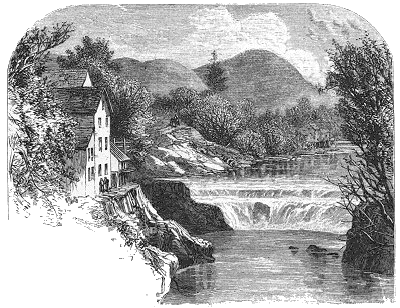
At The Gateway Of The Catskills - Part 2
by Ernest Ingersoll from May 1877 Harper's New
Monthly Magazine
|
|
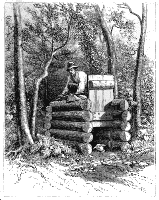 |
Every one in the Falls builds a pen of logs and
baits it for bears. Enos alone traps Bruin. When I saw him last
September he had three bear traps set, and was about to set another
over on the highest ridge of White Rock MT. These traps are little
houses, about eight feet long, three feet wide, and four feet wide,
made of logs as heavy as two men can lift. One end is left open, into
which a thick and heavy door of slabs is fitted, so as to slide up
and down in a groove. The whole is roofed over with logs, and pinned
and braced so as to resist the most violent efforts of the imprisoned brute.
In baiting, the door is lifted an poised on the
end of a stick balanced over a cross-piece, to the further end of
which the bit hangs. The bear must go quite into the pen to get at
the bait - usually a sheep's or calf's head - and the moment he tugs
at it he dislodges the door, which falls behind him, leaving Mr.
Bruin "in quod".
|
|
The ordinary heavy spring trap is also used,
but disliked on account of the danger of the hunter himself getting
caught, the success depending on the animal stumbling into it. This
trap consists of two semicircular pieces of iron with serrated edges,
so fastened together at their ends that when pried apart they lie
flat on the ground, with an iron plate between them big enough to
hold the foot of a bear.
|
|
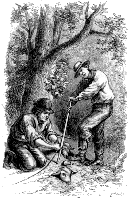 |
The contrivance resembles a shark's jaws, wide
open, and, chained to a tree, is hidden in the leaves, with the bait
just beyond, so that the bear must walk over the trap. Of he tries to
do so, he is tolerably sure to step on the hidden plate, and pressing
a trigger, releases the horrid jaws, which fly together and hold his
foot in clasp from which it is impossible to get free. The chain
prevents his limping away, and there he must stay and suffer till the
hunter, with his merciful rifle, comes to his deliverance. Sometimes,
to get free, the bear will gnaw off his leg at the first joint, and
leave his foot in the trap. Enos met with one such case in his own
experience, and having thrown the foot one side, another bear found
it and ate it.
Whichever trap is used, it is set near a
"wallow" - by which is meant a wet place where bears come
to roll in the mud and drink from the springs. They are very fond of
this amusement, being naturally playful, have paths more or less well
worn leading towards such wallows, and go there again and again with
their families to gambol on the soft banks.
|
|
A well constituted Catskill Ursus americanus
has almost as good a time as any animal I know of. He has a
magnificent country to roam through, there are not too many other
bears to divide the spoils with, the climate is not too hot in
midsummer, and in midwinter he can curl up in some snug retreat, suck
his paws, and sleep till vernal mildness calls him forth to new
wanderings. He is not bothered with many visitors - barring the
hunter and his hounds. If I could not be a butterfly, I should like
to be a bear. It amounts in the end chiefly to a choice between being
caught in a trap and perforated by a rifle-ball, or captured in a
silken net and bayoneted with a pin.
|
|
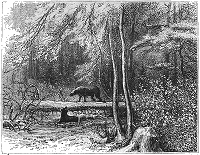 |
The bear is born in February (usually with a
single twin brother or sister), in some cave or hollow under the
roots of a tree, where his mother has "holed up" in a state
of partial hibernation when the first heavy snow came, and the cold
froze up the spring-holes. The old bears go into these caves
excessively fat, and seem so when they come out but their long fast
and the nursing of the young soon reduce them, so that they often
have a hard rub to keep alive if the spring is slow and their diet of
roots and bulbs is held tightly locked by late frosts
At such times they frequently become very bold,
making repeated attacks on the farmer's sheep and calves. Enos Brown
last spring had five sheep taken off in rapid succession. He
therefore stopped his farm-work, applied himself to trapping, and
soon five bear-skins graced his shanty's walls. His sheep were
avenged. During the spring and early summer, the bears live by their
wits - rather poorly - and are little hunted. They are shedding their
hair, so the fur is not in good plight, their flesh is lean, and
their young accompany them about the woods. The time to begin to hunt
them is when the woodland berries start to ripen. |
|
In the late autumn bears are also hunted with
dogs, and although the sport is very exciting, it is the hardest
imaginable work. The mountains are rugged and steep in the extreme,
covered with forest which are choked with a dense undergrowth of
huckleberries and briers, while fallen trees, rugged detached rocks,
and deep swampy gullies obstruct the way. To work one's way through
this tangle is not easy at best, and when one is hampered by a rifle,
ammunition, and other "fixin's", and is trying to keep up
with the excited dogs, the undertaking requires a man of steel. When
a bear finds itself pursued, it takes off up the steepest, most
inaccessible places, and over the very loftiest points in the whole
region, keeps on from peak to peak across the worst ravines and
through the densest jungles, fully aware that thus it will soonest
exhaust its pursuer, and finally escapes, if at all, through its
superior endurance. The hunter, knowing this, follows as best he can
with one or two tough little dogs, mere whiffets, which dash up and
nip the bear behind. When Bruin turns around in amazement and
indignation, the little dog is not there, but returns the instant the
bear starts on, and thus worries the bear into stopping and
attempting to fight its minute and pertinacious tormentor until the
hunter comes up and can shoot. |
|
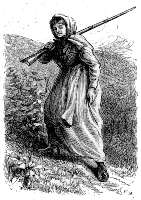 |
A large dog will attack the bear
boldly, and hold on until he is hugged to death - the speedy and
almost inevitable result of his incautious courage. A bear hunt of
this kind is full of adventure and fascination for the sportsman, yet
the chance of getting the bear in the end is a doubtful one. You are
sure, however, of a sinew-testing chase and a nerve-testing struggle
at the end. If an enraged bear is not a pleasant fellow to meet on
his native hills, a wounded one is still less so, and the hunter must
be self-possessed and agile to escape the formidable antagonist that
has failed to fall at his best shot.
Enos Brown tells a story of an adventure of
this kind he and his "woman" (Shokanites never say wife)
has when a very large bear submitted to be shot in the head,
straightened out with his head down hill, and have his throat cut,
and then suddenly revived and made exceedingly lively and sanguinary
work for the Brown family before consenting to yield up the ursine
ghost. Sometimes, moreover, a bear is lost through a provoking
accident, such as stupid dogs stopping to tree a porcupine, entirely
losing track of the nobler game, to the vexation of the breathless
hunter, who rushes up convinced from the dogs' racket that a whole
den of bears await his conquest. |
|
|







